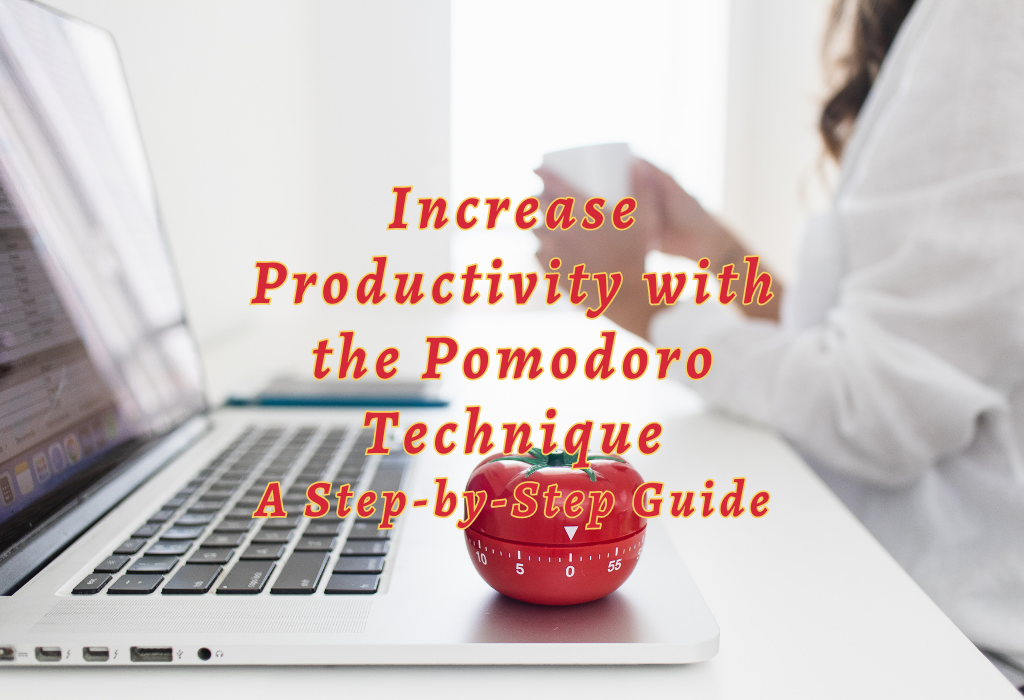Increase Productivity with the Pomodoro Technique: A Step-by-Step Guide
If you’re a multitasker trying to maximize your productivity, the Pomodoro Technique might be the answer you’ve been looking for.
On the surface, the Pomodoro Technique looks like a novel way to manage your day – break large tasks into smaller chunks and divide your time into 25-minute increments.
But there’s much more to it than that. Anyone who’s tried the Pomodoro Technique knows it can bring serious focus and productivity to your work.
In this post, we’ll look deeper into the Pomodoro Technique and provide a step-by-step guide to make the most of it.

Quick Definition_ The Pomodoro Technique is a time management method developed by Francesco Cirillo in the late 1980s. It breaks down work into 25-minute intervals with 5-minute breaks in between and encourages users to focus on one task to completion before moving on to the next.
What is the Pomodoro Technique?
The Pomodoro Technique is a time management system designed to help individuals increase productivity with more frequent, short breaks throughout the day. Developed by Francesco Cirillo in the late 1980s, it’s since become one of the most prevalent forms of time management methods used across the world and in multiple disciplines.
The basic premise is simple and straightforward: break down work into manageable chunks of 25 minutes (a “Pomodoro”) with 5-minute breaks between each and a longer break after 4 Pomodoros (about two hours). By forcing yourself to focus on one specific task at a time and taking frequent breaks, you’ll get more done and maintain motivation throughout your tasks.
Professionals have argued both for and against using this technique to maximize productivity. Those in favor point out that it provides structure during otherwise unstructured times, helps manage impulse and emotional responses, increases daily work output, and encourages prioritization in tackling tasks.
On the other hand, some professionals point out that this system might not be suitable for everyone—especially those who rely heavily on multitasking to get things done. Additionally, some note it may lead to higher stress levels related to time constraints without a definitive breakthrough or finish line.
Ultimately, it would help if you find what works best for you and your lifestyle. With that thought in mind, let’s explore how to implement the Pomodoro Technique. After learning about how the Pomodoro Technique works and why it may or may not be right for you, we can look deeper into how actually to apply it in our day-to-day lives. In the next section, we will discuss strategies and techniques for implementing the Pomodoro Technique into your daily routine.
Implementing the Pomodoro Technique
Implementing the Pomodoro Technique is a straightforward and simple process. First, you must decide which task to work on. Once you have identified the task, set a timer for 25 minutes. This period is known as Pomodoro. During this period, focus on completing just that one task. It is important to remember that every 25 minutes session should not be broken up by other tasks or distractions.
During the 25-minute period, interruptions should be minimized or eliminated if possible. Closely related to this point, decisions about which task to work on should acknowledge feasibility; it may not be realistic to complete some tasks in a single 25-minute pomodoro as some assignments require more time or concentration than those that can be feasibly accomplished in such a short amount of time. If a task takes more than 25 minutes to complete, break it apart into smaller parts that can each be completed in a single Pomodoro.
The next step after completing a pomodoro is to take a break. Five minutes if the Pomodoro was successful, or 10 minutes if multiple interruptions occurred during the Pomodoro session. Then, return to Step 1 and repeat the cycle until your task is finished.
By following these steps consistently, workers can make significant progress toward accomplishing their goals without feeling overwhelmed. Implementing The Pomodoro Technique can provide structure and clarity for staying on track with creative projects and larger tasks, leading to enhanced productivity and satisfaction in all areas of professional life.
In order to maximize effectiveness when using The Pomodoro Technique, it is important to note that self-discipline is key. Developing habits like minimizing distractions and only selecting tasks achievable within 25 minutes are surefire ways to succeed with this goal-setting strategy.
Now that we have discussed the mechanics of implementing The Pomodoro Technique let’s proceed with setting the timer and diving into our first act of focused work.
Setting the Timer
Now that you have identified your work tasks and goals, it’s time to set the timer. If you’re already familiar with the Pomodoro Technique, this part is rather straightforward. You must decide how much time will suffice for each Pomodoro session. Depending on the complexity of the task, most timers are typically at 25-minute intervals, with a 5-minute break in between sessions.
However, there is debate over whether longer timeframes should be allocated for certain tasks, especially those that might take a bit more thought or take more than 25 minutes to complete. On the one hand, many proponents of the Pomodoro Technique believe there should never be more than one session per task for efficiency and focus not to suffer.
However, some experts guarantee that if a task takes longer than 25 minutes, it may be worth splitting it into multiple sessions and taking slightly bigger breaks between them to stay motivated and prevent tiredness.
Ultimately, how long each Pomodoro session should depend on your personal preferences and how long it typically takes you to finish similar tasks. Once you have determined an appropriate length of a single session – be it 25 minutes or something else – start setting your timer and get to work.
Now that we’ve discussed how to set your timer let’s move to how to schedule short but effective breaks in between sessions of focused work.
Scheduling Short Breaks
Once you have your focus time and break times determined, it’s time to organize and schedule them into a routine. Scheduling short breaks is essential in allowing yourself the opportunity to take a few minutes away from what you are doing and turn off your computer or phone to reduce distractions.
A good rule of thumb for scheduling your breaks is five minutes for every 25 minutes you spend focused on a task. Make sure not to push your focus times too much and try not to let them overrun past their allotted time.
Many productivity experts agree that frequent rest periods can help with mental clarity and stress management, so try to include several 5-minute breaks throughout the day rather than one long break. Others argue that taking too many breaks can cause more harm than good due to constant context-switching.
To minimize this risk, it’s important to schedule your breaks within dedicated windows, staying focused on one task at a time without distraction until there is an adequate break planned in the schedule.
Plus, scheduling short breaks between focus sessions allow ample time for energizing moments, such as doing desk exercises, stretching, or walking around during the day. This will allow you to return from the break feeling refreshed and productive in the next work session, making it easier for you to complete each task efficiently.
Also, by adding short breaks within your workflow, it’s time to experience all the benefits of the Pomodoro technique. By understanding how implementing a cycle of shorter intervals of focus and rest affects productivity levels, users can learn how to get more done in less time while maintaining healthy habits throughout the process. Moving on to the next section, we’ll look at some specific ways this technique increases efficiency and creativity.
Crucial Points to Remember_ Implementing the Pomodoro technique, which involves segments of focus and rest, is an effective way to increase productivity and creativity. Scheduling 5-minute breaks for every 25 minutes you spend focused on a task is a good rule of thumb. Taking several small breaks throughout the day instead of one long break can help with mental clarity and stress management while minimizing unnecessary context switching. Exercise or stretching during short breaks is recommended to return feeling refreshed and more productive.
Benefits of the Pomodoro Technique
The Pomodoro Technique has many potential benefits, from improved focus and productivity to a greater sense of well-being. With its focus on frequent breaks, the Pomodoro Technique allows users to combat fatigue caused by monotonous long hours. By separating tasks into short work intervals with breaks in between, it helps to keep energy levels high throughout the day. Additionally, breaking bigger tasks into smaller ones can help motivate and make them easier to manage.
On the other hand, some people point out that too many interruptions can cause more stress. They argue that without large chunks of uninterrupted time, it can be difficult to maintain a flow state capable of producing optimal results. Furthermore, switching back and forth between tasks could lead to wasted time since getting back up to speed after each break will take some time.
However, by using the Pomodoro Technique properly and effectively scheduling breaks, these potential downsides can be minimized. A well-timed break can actually provide users with the mental boost needed to stay focused and on top of their task list for longer than would otherwise be possible without taking one.
From improved focus and productivity to a greater sense of well-being, the Pomodoro Technique offers several benefits when used correctly. The next section explores how this technique can be used to increase focus and productivity even further.
Increased Focus and Productivity
The Pomodoro Technique is best known for its ability to increase focus and productivity. By breaking larger tasks down into chunks of 25-minute intervals, it allows users to maintain lasting concentration on a subject, avoid fatigue, and stay motivated to finish the task quicker. This helps to make it easier for workers to plan out their day with longer chunks of time that can be dedicated to individual tasks instead of switching from one task to another in a shorter span.
It is not just the allocated time that keeps workers focused and productive. It’s also the predetermined breaks that give people relief from hours of work while also preventing burnout. Breaks in between work sessions refresh minds, reduce errors, build enthusiasm, and empower people to give 100% effort when they return to their tasks.
Despite its promises of increased focus and productivity, the Pomodoro Technique might not be suitable for everyone. Not all people naturally fall into short bursts of intense focus followed by rest breaks. Some may find a traditional approach to uninterrupted work more successful, so it is important to try both approaches before making a permanent decision.
At the end of the day, though, the Pomodoro Technique has displayed results as an effective way to increase focus and productivity in workers. Accounting for both sides of the argument, employers should at least consider this method for employees who are looking for a method better suited for themselves than traditional ways of working. With that in mind, let’s explore how one can apply the Pomodoro Technique across different work tasks.
Using the Pomodoro Technique for Different Tasks
When it comes to using the Pomodoro Technique for long projects, it can be difficult to stay focused for an extended period. By breaking down larger projects into smaller pieces and working in shorter 25-minute increments, productivity increases as motivation are heightened when short-term goals are achieved.
On the other hand, some experts argue that since any negotiation of task duration limits completion times, it might become less productive in terms of the total time invested in getting the job done.
Regardless of what side of the fence you stand on when it comes to the most effective use of the Pomodoro Technique for different tasks, one thing remains clear_ its utility in providing an organized schedule can limit distractions from external influences allowing users to control their productivity.
Making the Pomodoro Technique part of your daily workflow is essential if you want to maximize productivity and get through challenging projects efficiently. The next section will discuss how you can make this happen.
Making the Pomodoro Technique Part of Your Daily Workflow
Putting the Pomodoro Technique into practice requires an upfront investment of time and dedication. Like any good habit, it takes a while to get used to, and then you’ll see the benefits almost immediately. The idea is to separate larger tasks into smaller segments, interspersed with short breaks.
This will not only give you some rest between spurts of productivity but also prevent burnout or fatigue. Additionally, by balancing work and break times, your energy will remain consistent throughout the day.
Many opponents of the Pomodoro Technique argue that it does not consider individual lifestyle variables such as motivation levels. However, research has found that when properly adapted to one’s individual needs, this technique can actually help in developing better work habits and improved energy levels even in the long term.
Ultimately, you’re going to have to find what works best for you –but the key is breaking down your daily tasks further into manageable chunks rather than tackling everything all at once. Doing this will help keep distractions at bay and maximize productivity during each Pomodoro session.
Now that we’ve explored what the Pomodoro Technique is and how it can benefit your workload, let’s move on to discussing its overall performance in our next section: Conclusion and Overall Review of the Pomodoro Technique. But first, let’s see the top-rated apps for the Pomodoro technique.
Top-Rated Apps for Pomodoro Technique
If you find the idea of tracking your workday daunting, there are many available Pomodoro timer apps to make it easier. I found that downloading one on my phone was incredibly helpful for this experiment, and I suggest trying it if you want to give one a go.
iPhone users should try Focus Keeper or Pomodoro – Focus Timer (the latter has more customizable features), while Android owners can use Pomodoro Timer Lite. Give them all a shot and see which works best for you!
Conclusion and Overall Review of the Pomodoro Technique
The Pomodoro Technique has been recommended as an efficient way to keep oneself organized and productive, with numerous benefits. It is a powerful time management system that can help individuals to prioritize tasks effectively, reduce procrastination and eliminate multitasking.
The technique provides structure, focus, and motivation during work sessions, allowing one to stay on task and complete projects within a short amount of time. Additionally, it empowers users with greater control over their timeline and leads to higher productivity levels.
However, the technique also comes with certain drawbacks. Those who have trouble staying motivated or with self-discipline may find it difficult to stick to the 25-minute cycles and reap the full benefits of the method. Additionally, some people may struggle due to constant distractions from phone notifications or other external sources.
On balance, the Pomodoro Technique is generally a very effective way for individuals to increase their productivity. By identifying manageable chunks of work, removing distractions, and providing regular breaks, this technique can empower individuals to stay focused and maximize their efficiency without burnout. For those wanting to up their productivity game and make better use of their available time, this is a great strategy worth trying out.






